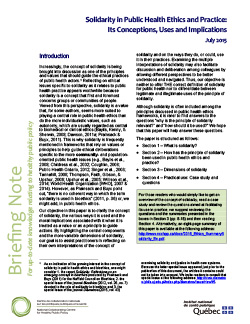Solidarity in Public Health Ethics and Practice: Its Conceptions, Uses and Implications
Increasingly, the concept of solidarity is being brought into discussion as one of the principles and values that should guide the ethical practices of public health actors.1 Reflecting on ethical issues specific to solidarity as it relates to public health practice appears worthwhile because solidarity is a concept that first and foremost concerns groups or communities of people. Viewed from this perspective, solidarity is a value that, for some authors, seems more suited to playing a central role in public health ethics than do the more individualistic values, such as autonomy, which are usually regarded as central to biomedical or clinical ethics (Baylis, Kenny, & Sherwin, 2008; Dawson, 2011a; Prainsack & Buyx, 2011). This is why solidarity is frequently mentioned in frameworks that rely on values or principles to help guide ethical deliberations specific to the more community- and population-oriented public health issues (e.g., Baylis et al., 2008; Childress et al., 2002; Coughlin, 2008; Public Health Ontario, 2012; Singer et al., 2003; Tannahill, 2008; Thompson, Faith, Gibson, & Upshur, 2006; Upshur et al., 2005; Willison et al., 2014; World Health Organization [WHO], 2007 & 2014). However, as Prainsack and Buyx point out, “there is no coherent way in which the term solidarity is used in bioethics” (2011, p. 36) or, we might add, in public health ethics.
Our objective in this paper is to clarify the concept of solidarity, the various ways it is used and the moral implications associated with it when it is treated as a value or as a principle to guide actions. By highlighting the central components and the more variable dimensions of solidarity, our goal is to assist practitioners in reflecting on their own interpretations of the concept of solidarity and on the ways they do, or could, use it in their practices. Examining the multiple interpretations of solidarity may also facilitate discussion and deliberation among colleagues by allowing different perspectives to be better understood and navigated. Thus, our objective is neither to offer THE correct definition of solidarity for public health nor to differentiate between legitimate and illegitimate uses of the principle of solidarity.
Although solidarity is often included among the principles discussed in public health ethics frameworks, it is rarer to find answers to the questions “why is the principle of solidarity relevant?” and “how should it be used?” We hope that this paper will help answer these questions.
The paper is structured as follows:
- Section 1 – What is solidarity?
- Section 2 – How has the principle of solidarity been used in public health ethics and practice?
- Section 3 – Dimensions of solidarity
- Section 4 – Practical use: Case study and questions
1 As an indication of the growing interest in the concept of solidarity in public health ethics and bioethics, one might consider 1. the report Solidarity: Reflections on an emerging concept in bioethics produced by Prainsack and Buyx (2011) for the Nuffield Council on Bioethics; 2. the special issue of the journal Bioethics (2012, vol. 26, no. 7) devoted to the role of solidarity in bioethics; and 3. the special issue of the journal Diametros (2015, vol. 43) examining solidarity and justice in health care systems. Because the latter special issue appeared just prior to the publication of this document, the articles it contains could not be taken into account. We invite readers to consult that special issue at the following address: http://www.diametros.iphils.uj.edu.pl/index.php/diametros/issue/view/45.


